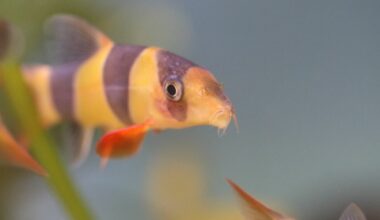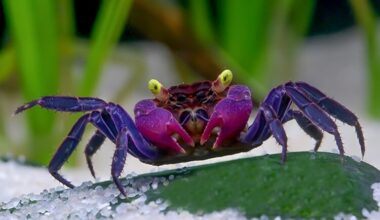The Diamond Goby is a fascinating addition to any marine aquarium, known for its unique appearance and intriguing behavior. With its striking diamond-like pattern and vibrant colors, the Diamond Goby is sure to catch your eye. But there’s more to this little gem than meets the eye!
As we explore the care requirements of the Diamond Goby, we’ll uncover its interesting habits, such as its burrowing behavior and symbiotic relationship with pistol shrimp. Join us as we dive into the wonderful world of Diamond Goby care, and discover the secrets to creating a thriving environment for this remarkable species.
Let’s embark on this exciting journey together!
Table of Contents
Species Summary
Known under the scientific name of Valenciennea puellaris, the diamond goby is a hardy reef fish with an easygoing personality. Just be sure to keep up with landscaping inside the tank once this fish moves in.
Diamond gobies have a penchant for playful digging because they are natural-born scavengers who sift through the ocean’s sands searching for edible debris. In many cases, this sifting “hobby” can be disruptive enough to displace rocks and corals inside an aquarium.
Both beginners and seasoned tank curators can appreciate the prestige of adding this stunner that’s native to Fiji and surrounding atolls peppered throughout the Indian Ocean and Western Pacific.
Author Note: The diamond goby is sometimes called by the names of the diamond watchman goby, the diamond sleeper goby, the orange spotted goby, the orange dashed goby, the maiden, and pretty prawn.
Appearance
The diamond goby has an elongated shape that shows off citrine markings of yellow and orange that streak vertically down its pale, glassy body. The semi-transparent body of the diamond goby helps this creature to happily remain inconspicuous while sifting through coral or rocks in its natural habitat.
The body has both a spiny and dorsal fin to create beautiful fluttering movements that can be enjoyed when the diamond goby isn’t playing its usual game of cloak and dagger in the sand.
Additionally, the large head and eyes of the diamond goby give it a cartoon-like appearance. When looking closely at the diamond goby, it’s impossible not to notice an oversized jaw with sky-blue markings.

Lifespan
When welcoming home a new Diamond Goby, the fish can be expected to have a lifespan of 5 to 8 years in captivity. So much of a goby’s longevity comes down to proper feeding and tank conditions.
Average Size
The Diamond goby is a medium-to-large fish that really stands out in a tank with an acreage size of 5 to 7 inches in adulthood. Most diamond gobies will grow to 6 inches even. While some have grown to 8 inches, this is a rarity.
Diamond Goby Care
While the diamond goby is considered a relatively easy fish to care for, its living conditions must be precise in order for this busy sand sifter to survive. As obsessive burrowers and diggers, these fish thrive when given deep sand beds.
Author Note: The fact that they can survive with “bare” tanks doesn’t mean that this is what their biology desires. The simple rule is to always give a goby sand!
When coordinating a tank environment, the need-to-know, life-or-death information is that diamond gobies are incredible jumpers. While it can catch a first-time owner by surprise, this fish can very easily leap out of a tank to meet its demise if a top or lid isn’t in place.
As many have learned, even diamond gobies that seem perfectly settled will still make this fateful leap to your home’s “dry land.”
Tank Size
As a medium-to-large saltwater fish, the recommended tank size for a Diamond Goby is at least 30 gallons. Due to the sifting nature of these fish, an elongated tank with dimensions somewhere along the lines of 30 inches x 12 inches works nicely.
Feel free to go as big as double that when planning to pair gobies with other sand sifters to create more surface area to ward off fighting over territory.
Water Parameters
- Water temperature: Tank should be maintained at 72°F to 78°F.
- pH levels: pH should fall between 8.1 and 8.5. Check at least weekly to maintain this goby-safe range.
- Water hardness: A hardness of 8 to 12 dKH is needed for a diamond goby’s survival.
- Specific gravity: Maintain salinity between 1.020 and 1.025 sg.
Tank Setup
Diamond gobies set up shop in the bottom half of an aquarium after moving in. Providing a goby with 3 inches of soft-sand substrate allows them to feel secure. This sand is where the fish will seek out rest and refuge from stress.
Additionally, the diamond goby thoroughly appreciates rock formations. Just be sure that these formations can be firmly affixed to the sand because they can turn into risk factors when dislodged by a diamond goby in vigorous digging mode.
The diamond goby tends to be happiest in a moderately lit tank with good water flow. As mentioned above, keeping a lid or top on the aquarium can prevent the all-to-common tumbling tragedies that plague diamond gobies who answer the call of the void.
Are Diamond Gobies Reef-Safe?
Diamond Gobies are reef-safe fish but their habits can create some annoyances. First, the constant sifting and digging of the diamond goby can disrupt live corals and rocks.
While this fish’s gills are designed to carefully filter sand, the diamond goby has a very uncouth habit of suddenly spitting out sand when their findings aren’t to their liking. The irritating spit sometimes lands on corals but typically isn’t a big deal. Fortunately, this is the extent of it because diamond gobies do not pick at or nibble on coral.
Common Possible Diseases & Prevention
The diamond goby isn’t particularly vulnerable to diseases. However, ich is always a possibility for this saltwater fish. A parasitic disease that attaches to the gills, fins, or skin after entering the body, this transmittable threat can spread quickly through an aquarium. Signs of ich in the diamond goby include lethargy, lack of interest in food, and visible white spots on the skin.
The best way to prevent ich is to quarantine all new fish before introducing them to the tank environment. If a fish is suspected of having ich, it should be quarantined away from the tank as soon as symptoms are present.
Food & Diet
Diamond Gobies have a carnivore diet and they are bottom feeders by nature. To keep a diamond goby healthy, design a diet plan to include live servings of krill, mysis (false shrimp), brine shrimp, copepods, and krill when possible. Sinking pellets and flakes will also be eaten by diamond gobies.
Generally, gobies should be fed smaller portions two to three times daily. It’s also important to keep a watchful eye on the tank at feeding time to ensure that gobies aren’t missing out. Due to their bottom-feeder status, the diamond goby sometimes doesn’t reach food fast enough during a feeding frenzy. This fish will patiently wait for morsels to reach the bottom of the tank while others dine.
Author Note: A workaround for this problem is to use some kind of delivery line to place food right within the goby’s reach. Some people even use a simple turkey baster to deposit morsels where the goby can reach them without competition.
Behavior & Temperament
The diamond goby is generally known to be a peaceful fish that acts like a worker bee when it comes to mining the tank’s rich sand for microorganisms. It spends most of its time busily burrowing. While this can create some commotion within the tank, the goby’s habits are generally undisruptive to other fish.
Of course, giving a goby plenty of territory offering sand and hiding spots is the key to preventing this fish from becoming aggressive. Like all fish, the goby will act out when stressed by poor tank conditions or overcrowding.
Sharing a home with the Pistol Shrimp
The Diamond Goby builds a symbiotic relationship with the Pistol Shrimp by being the watchman against predators in exchange for sharing the shrimp’s burrow. This is because the Pistol Shrimp is nearly blind.

Diamond Goby Tank Mates
Diamond Gobies live harmoniously with a wide variety of other fish and creatures. They do best with fellow reef-safe, nonaggressive fish. Perfect matches include:
- Clownfish
- Pistol Shrimp
- Foxface rabbitfish
- Cleaner wrasse
- Dwarf angelfish
- Damsel
Author Note: While several diamond gobies can technically share an aquarium, they are known to get aggressive when their burrowing spaces are too close. This can happen in all but the biggest of tanks. While a single goby is ideal, a mating pair can also get along nicely.
Breeding
The diamond goby is a very interesting and unique breeder. In addition to being natural sand sifters, they are also natural romantics. Yes, a diamond goby pair will form a bond for life. It’s also common for these couples to be gathered and sold as pairs.
Author Note: To know that a diamond goby is matched for life, check for two gobies hiding in a single spot in a tank. Buying a pair is the kind thing to do in this case.
Telling male and female diamond gobies apart is nearly impossible! While the males are sometimes bigger than the females, this isn’t necessarily a foolproof method of sexing this species. The diamond goby is also what’s known as a protogynous fish. This means that it is capable of changing its sex when pairing up.
When breeding, the diamond goby typically positions its fertilized eggs directly over its burrow. The male goby will then keep watch for up to four days while providing oxygen via a fanning mechanism
Conclusion
In conclusion, we hope this Diamond Goby care guide has provided you with valuable insights and guidance on how to ensure the well-being of this remarkable species in your saltwater aquarium. We believe that responsible care and understanding of this fish’s unique needs are essential for fostering a thriving environment.
Watching the Diamond Goby diligently sift through sand and interact with its surroundings is a testament to the beauty and complexity of marine life.
We encourage you check our other care guides and to share your experiences and knowledge with fellow aquarists. And don’t forget to let us know how everything is going, maybe even tag us on Facebook with a nice picture of Goby!
Happy fishkeeping!

